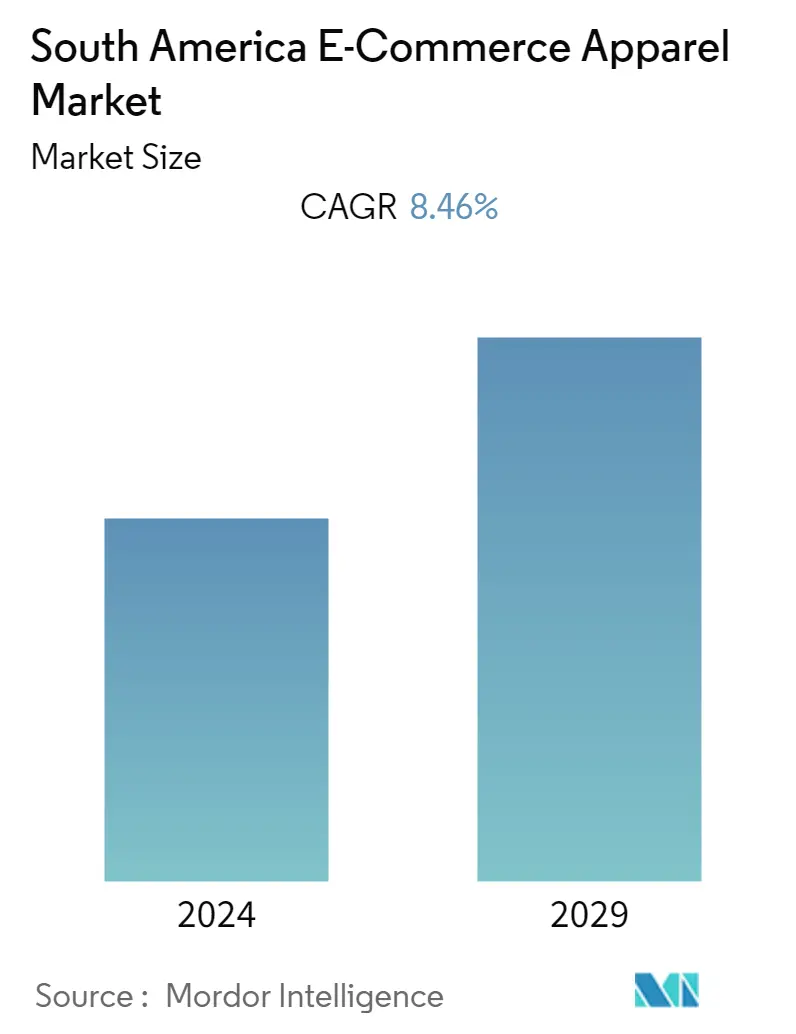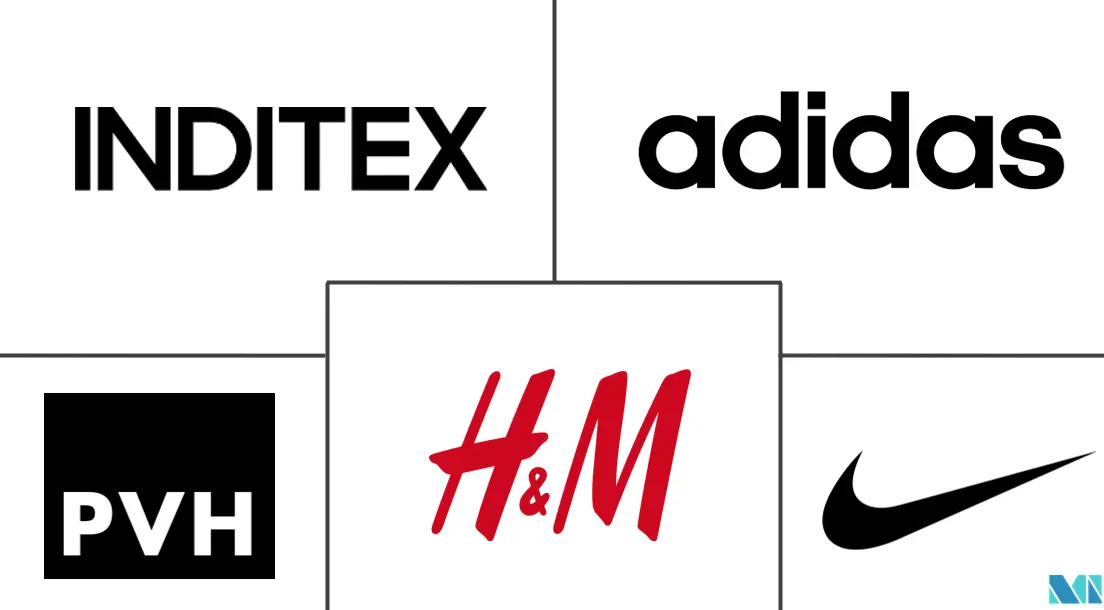Market Size of South America E-Commerce Apparel Industry

| Study Period | 2019 - 2029 |
| Base Year For Estimation | 2023 |
| Forecast Data Period | 2024 - 2029 |
| Historical Data Period | 2019 - 2022 |
| CAGR | 8.46 % |
| Market Concentration | Low |
Major Players
*Disclaimer: Major Players sorted in no particular order |
South America E-Commerce Apparel Market Analysis
- The South America e-commerce apparel market was valued at USD 12,365.27 million for the current year and is projected to register a CAGR of 8.46% over the next five years.
- The growth of social media in the region has had a significant impact, especially on millennials, affecting their purchasing behavior via social media platforms and internet channels. Thus, the sales of apparel through online stores have witnessed rapid growth in recent years owing to the level of convenience that it provides for consumers. Furthermore, e-commerce platforms are gaining market share in terms of revenue, popularity, and a diverse range of products from both local and worldwide brands.
- According to Fundação Getúlio Vargas, in 2021, Lojas Renner was the top-performing fashion shop in Brazil, with net sales of over BRL 10.5 billion. Guararapes Online, a clothing and accessory company, had net sales of almost BRL 7 billion (USD 1.26 billion) that year, making it the second retailer in the country's fashion industry. This instance advocates the growth of the e-commerce apparel industry across the region.
- Online retail stores have been growing in popularity as the platform offers the ease of buying from the comfort of one's home, as well as product descriptions, a questionnaire regarding sizes, a more thorough selection of different brands, and a greater diversity of materials, patterns, and no capital requirement for setting up a store like in case of supermarkets or specialty stores. Hence, the players offering apparel across the region have been exploring the e-commerce retail space to gain major market shares in the market studied. For instance, in 2021, Calvin Klein, a subsidiary of PVH Corp., announced the launch of its e-commerce in Peru. This launch marks the latest addition to the growing Calvin Klein e-commerce portfolio across South America and gives customers across the region access to shop online for men's and women's apparel offerings. Hence, the availability of various brands on the e-commerce platforms and other factors such as the time-saving viewpoint, easy-to-navigate online shopping portals, hassle-free online payments, and in-home delivery is expected to be rising and are expected to boost the e-commerce apparel market across the region.
South America E-Commerce Apparel Industry Segmentation
Apparel, also known as clothing, can be defined as garments that are worn on the body. E-commerce apparel refers to the buying and selling of fashion and apparel products online, specifically through e-commerce platforms.
The South America E-commerce Apparel Market is segmented by product type, end-user, platform type, and geography. Based on product type, the market is segmented into formal wear, casual wear, sportswear, nightwear, and other types. By end user, the market is segmented into men, women, and kids/children. The market is segmented by platform type into third-party retailers and the company's own website. The study also covers the regional-level analysis of the major countries, including Brazil, Argentina, and the Rest of South America.
The market sizing has been done in value terms in USD for all the abovementioned segments.
| Product Type | |
| Formal Wear | |
| Casual Wear | |
| Sportswear | |
| Nightwear | |
| Other Types |
| End User | |
| Men | |
| Women | |
| Kids/Children |
| Platform Type | |
| Third Party Retailer | |
| Company's Own Website |
| Geography | |
| Brazil | |
| Argentina | |
| Rest of South America |
South America E-Commerce Apparel Market Size Summary
The South America e-commerce apparel market is experiencing significant growth, driven by the increasing influence of social media and the convenience of online shopping. The rise of social media platforms has notably impacted millennials, altering their purchasing behaviors and boosting online apparel sales. E-commerce platforms are expanding their market share by offering a wide range of products from both local and international brands, providing consumers with the ease of shopping from home, detailed product descriptions, and diverse options in materials and styles. This shift towards online retail is further supported by the absence of capital requirements for setting up online stores compared to traditional retail outlets. The market is characterized by the entry of major brands into the e-commerce space, enhancing their reach and accessibility across the region.
Brazil stands out as the dominant country in this market, with factors such as job creation, increased disposable income, and evolving fashion trends contributing to its growth. The popularity of athleisure wear has also influenced consumer preferences, prompting brands to expand their omnichannel distribution strategies. The market is highly fragmented, with numerous players like H&M, PVH Corp., Adidas, Nike, and INDITEX leveraging their extensive product portfolios and investments in research and development to maintain a competitive edge. These companies are expanding their presence on various e-commerce platforms, enhancing brand loyalty and economies of scale. The ongoing development of e-commerce channels and the growing acceptance of online shopping are expected to continue driving market growth across South America.
South America E-Commerce Apparel Market Market Size - Table of Contents
-
1. MARKET DYNAMICS
-
1.1 Market Drivers
-
1.1.1 Increased Influence of Social Media and Aggressive Marketing
-
1.1.2 Growing Popularity of Athleisure Apparel Across E-commerce Channels
-
-
1.2 Market Restraints
-
1.2.1 Competition From Brick-and-Mortar Retail Channel
-
-
1.3 Porter's Five Forces Analysis
-
1.3.1 Threat of New Entrants
-
1.3.2 Bargaining Power of Buyers/Consumers
-
1.3.3 Bargaining Power of Suppliers
-
1.3.4 Threat of Substitute Products
-
1.3.5 Intensity of Competitive Rivalry
-
-
-
2. MARKET SEGMENTATION
-
2.1 Product Type
-
2.1.1 Formal Wear
-
2.1.2 Casual Wear
-
2.1.3 Sportswear
-
2.1.4 Nightwear
-
2.1.5 Other Types
-
-
2.2 End User
-
2.2.1 Men
-
2.2.2 Women
-
2.2.3 Kids/Children
-
-
2.3 Platform Type
-
2.3.1 Third Party Retailer
-
2.3.2 Company's Own Website
-
-
2.4 Geography
-
2.4.1 Brazil
-
2.4.2 Argentina
-
2.4.3 Rest of South America
-
-
South America E-Commerce Apparel Market Market Size FAQs
What is the current South America E-Commerce Apparel Market size?
The South America E-Commerce Apparel Market is projected to register a CAGR of 8.46% during the forecast period (2024-2029)
Who are the key players in South America E-Commerce Apparel Market ?
PVH Corp., Adidas AG, H & M Hennes & Mauritz AB, Nike Inc and Industria de Diseño Textil, S.A. (INDITEX) are the major companies operating in the South America E-Commerce Apparel Market .

